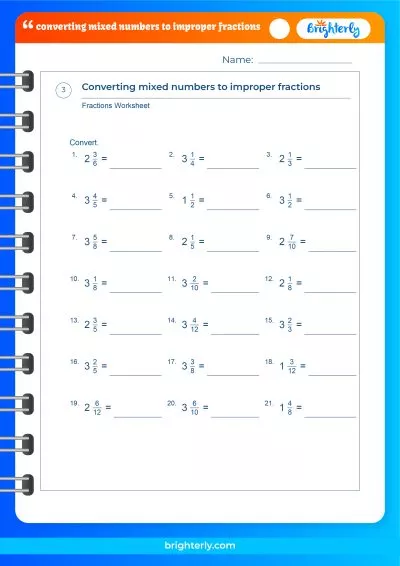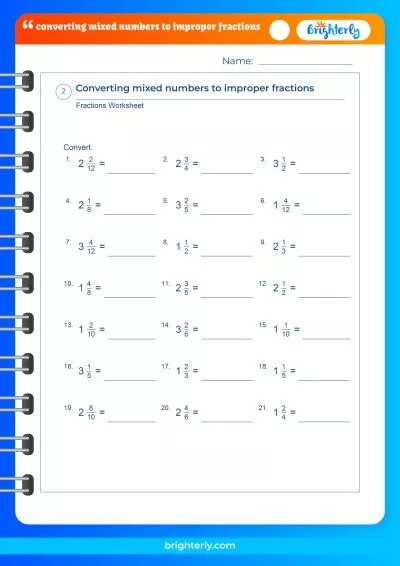Improper Fractions – Definition, Conversion, Examples, FAQs
Updated on January 4, 2024
Welcome to another exciting exploration into the grand universe of mathematics, presented to you by Brighterly. Today, we delve into a specific type of fraction, known as the improper fraction. Despite its somewhat unusual name, the improper fraction is an integral part of the fractional family and a vital component of understanding mathematical operations. An improper fraction is characterized by a numerator (the top number) that is larger than its denominator (the bottom number). This configuration means that the fraction represents a value greater than one. Examples of improper fractions include 7/3 or 9/2. While they might look slightly unconventional, they are used frequently in various mathematical calculations and real-world scenarios. Understanding and working with improper fractions is a key step in your math journey, and with Brighterly’s guidance, you’ll soon master this essential concept.
What is an Improper Fraction?
The wonderful world of fractions has many facets to explore. One particular type, known as the improper fraction, might sound a bit unusual at first, but it’s a fundamental part of understanding and working with fractions. In an improper fraction, the numerator (the top number) is larger than the denominator (the bottom number). In simple terms, this implies that the fraction is greater than one. For instance, 7/3 or 9/2 are examples of improper fractions. They may look slightly different from what you’re accustomed to seeing, but rest assured, they play a significant role in various mathematical calculations. You might find them while doing complex arithmetic operations or solving real-life problems. Embrace them, for they are an integral part of your math journey.
How to Simplify Improper Fractions?
Simplifying improper fractions can initially seem like a daunting task, but it’s quite straightforward once you grasp the core concept. The goal is to reduce the fraction to its simplest form, while still keeping the value the same. Here’s how you do it: First, find the greatest common divisor (GCD) of the numerator and the denominator. Then, divide both the numerator and denominator by this GCD. The resulting fraction is your simplified improper fraction. If the GCD is one, then the improper fraction is already in its simplest form! For example, in the fraction 8/4, the GCD is 4. Dividing both 8 and 4 by 4 gives us the simplified fraction 2/1. Easy, right?
Improper Fractions to Mixed Fractions
Converting improper fractions to mixed fractions is an essential skill in the realm of mathematics. A mixed fraction consists of a whole number and a proper fraction. To convert an improper fraction into a mixed fraction, you simply divide the numerator by the denominator. The quotient becomes the whole number, while the remainder over the denominator becomes the proper fraction. For instance, 7/3 converted to a mixed fraction would result in 2 1/3. This process helps make fractions more easily understandable and interpretable in real-world contexts.
Mixed to Improper Fraction
The inverse process, turning mixed fractions into improper fractions, is also quite handy. For this, you first multiply the whole number by the denominator of the fraction part, then add this result to the numerator of the fraction part. The resulting number is the numerator of your new improper fraction, with the denominator staying the same. So, if you start with the mixed number 2 1/3, you’d multiply 2 by 3 (getting 6), then add 1 to get 7. Thus, 2 1/3 becomes 7/3 when converted to an improper fraction.
Addition of Improper Fractions
Adding improper fractions involves a couple of steps. First, ensure the fractions have a common denominator. If they don’t, you need to find the least common denominator (LCD) and convert each fraction accordingly. Then, simply add the numerators of the fractions to get your answer’s numerator. The denominator will remain the same. For instance, 7/3 + 2/3 = 9/3.
Subtraction of Improper Fractions
Subtraction of improper fractions is similar to addition. The key is again ensuring the fractions have a common denominator. If not, find the LCD and adjust the fractions. Then, subtract the numerators to find the numerator of the answer. The denominator remains the same. So, 9/2 - 3/2 = 6/2.
Converting Improper Fractions to Decimals
Converting an improper fraction to a decimal involves simple division. You divide the numerator by the denominator. The resulting decimal number is the decimal equivalent of the improper fraction. So, 7/3 as a decimal is 2.333....
Converting Improper Fractions to Mixed Numbers
We’ve already covered this process in detail above, but it’s worth reiterating. Converting improper fractions to mixed numbers makes them easier to interpret, especially in practical applications. Remember, you simply divide the numerator by the denominator to find the whole number, and the remainder becomes the numerator of the fractional part.
At Brighterly, we believe that practice is the key to mastery. That’s why we invite you to explore our improper fractions worksheets, where you can find an array of additional practice questions, complete with answers.
How to Solve Improper Fractions?
“Solving” an improper fraction typically means converting it to a simpler form like a mixed number or decimal, or using it in an operation like addition or subtraction. The specific steps involved depend on the type of problem you’re solving. For instance, you might convert the fraction to a decimal to make it easier to understand or use in calculations. Or, you might convert it to a mixed number for easier interpretation in a real-world context.
Solved Examples on Improper Fractions
-
Simplifying an Improper Fraction: Simplify
15/9. The GCD of15and9is3. Divide both numbers by3to get the simplified fraction5/3. -
Converting an Improper Fraction to a Mixed Number: Convert
22/7to a mixed number. Divide22by7to get3with a remainder of1. So,22/7is equal to3 1/7.
Practice Problems on Improper Fractions
- Convert
16/5into a mixed fraction. - Simplify the improper fraction
24/16. - Convert
7/3into a decimal. - Add
5/2and3/2. - Subtract
9/4from13/4.
Conclusion
To conclude, improper fractions, though perhaps a little unfamiliar at first, are a fundamental part of understanding fractions as a whole. With consistent practice and the right guidance, you can master the process of simplifying these fractions, converting them into mixed numbers, and performing various arithmetic operations on them. Remember that improper fractions, like any other mathematical concept, are just tools to represent and work with numbers. They can often make working with fractions easier and more intuitive.
At Brighterly, we believe in making mathematics accessible, fun, and engaging for all learners. We hope this deep dive into improper fractions has been enlightening and useful. Remember, it’s all about taking one step at a time. Keep exploring, keep asking questions, and keep enjoying the incredible journey of learning with Brighterly.
Frequently Asked Questions on Improper Fractions
What is an improper fraction?
An improper fraction is a type of fraction where the numerator (top number) is larger than the denominator (bottom number). This implies that the value of the fraction is greater than one. It’s just a way of expressing numbers and is not “improper” in any negative sense. It’s often used in mathematical calculations and real-life situations where quantities exceed a whole unit but are still fractional.
How do you simplify improper fractions?
Simplifying improper fractions involves finding the greatest common divisor (GCD) of the numerator and denominator and then dividing both numbers by this GCD. If 12/8 is your improper fraction, first find the GCD of 12 and 8, which is 4. Next, divide both 12 and 8 by 4 and you’ll get 3/2, which is the simplified version of your initial improper fraction. The fraction still represents the same value, but it’s now expressed in its simplest form.
How do you convert improper fractions to mixed numbers?
Converting improper fractions to mixed numbers is a straightforward process that involves division. By dividing the numerator by the denominator, you can determine the whole number part of the mixed number. Any remainder then forms the numerator of the proper fraction part of the mixed number. For instance, if you have the improper fraction 22/7, when you divide 22 by 7, you get 3 with a remainder of 1. This implies that 22/7 as a mixed number is 3 1/7.






